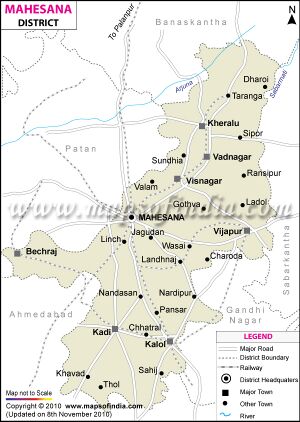Taranga
| Author:Laxman Burdak, IFS (R) |

Taranga hill (तरंग) is a Jain pilgrim near Kheralu in Mehsana district, Gujarat, India. Its ancient name was Taranagarh (तारणगढ़).
Origin
Variants
- Taranagarh (तारणगढ़) (AS, p.397)
- Taranga hill (तरंग पहाड़ी) (AS, p.397)
- Taranga (तारंगा) (AS, p.397)
- Taranga (तरंग) दे. Taranagadha तारणगढ़ (AS, p.392)
History
Taranga is a Jain pilgrimage center near Kheralu in Mehsana district, Gujarat, India. The oldest Jain temple constructed in 1121 by the Chaulukya king Kumarapala, under the advice of his teacher, Acharya Hemachandra. The Svetambara compound consists of 14 temples in all. There are also five other Digambara-affiliated temples at Taranga hill. The place was historically associated with Buddhism and the monuments dated to 4th-8th century are found here.
Taranga became important Jain pilgrimage site after 12th century. In Kumarapala Pratibodha of Somaprabhacharya, composed in Vikram Samvat 1241, states the local Buddhist king Veni Vatsaraja and Jain monk Khaputacharya had built a temple for goddess Tara and thus the town was named Tarapur.[1]
The hill for the most part covered with brushwood and forest is, on the east and west, crossed by road that lead to a plateau where stand the temples built of white sandstone and brick. The main temple was built by Chaulukya king Kumarapala (1143 - 1174) after he became follower of Jainism under his teacher Acharya Hemchandra.[2]
Known history of Vadnagar goes back to more than 2500 years. Vadnagar is referred to as Anartapur (आनर्तपुर) in Mahabharata. According to the great epic the Anarta warriors fought in the Mahabharata war on both the sides and the feud among them continued even after the war was over. Recent archaeological excavations have established the existence of a thriving city of religious and cultural activities at the location around the 1st century. Gujarat historians are thrilled at the discovery of a four-km long fortification south-west of Taranga Hills, comprising Jogida, Shamalia and Dhagolia, in Mehsana district. It was discovered in May 2009 and kept a closely guarded secret by the state archaeology department. They have all the reasons to believe that this could be the city of Anartapura, the fabled land of warriors and the possible origin of Gujarat. [3]
Buddhist monuments
The earliest archaeological were reported in 1938. The place was historically associated with Buddhism when Vadnagar was also under Buddhist influence in 4th-5th century. The Taranga hill bears the name of Taringa or Taranga, probably from a shrine of Taran Mata.[4]
About 2.5 km north of the hill, the shrines of Taran Mata and Dharan Mata is situated near a natural stream. These shrines are built on high platform. The idol of local deity Taran Mata in the shrine is of Buddhist deity Tara originally. There are other Buddhist statues including Avalokiteshwara Padmapani there. The idol of Taran Mata is dated to 8th-9th century based on its style. The construction of the right side of the stream is probably an altered Buddhist stupa. Two large-sized terracotta images of Buddha were found here in the past which were dated to last quarter of the 4th century based on their style.[5][6][7][8]
There are also ancient cave shelters. Nearby cave, locally known as Jogida ni Gafa has a relics of four Buddhist statues known as Dhyani Buddhas under the Bodhivriksha. The cave was used by Buddhist monks years ago.[9][10][11]
तारंगा
विजयेन्द्र कुमार माथुर[12] ने लेख किया है ...तारंगा (AS, p.397) - तारंगा हिलस्टेशन से 4 मील दूर दिगंबर जैनों का तीर्थ जहाँ 73 प्राचीन मंदिर हैं. संभवनाथ के मंदिर के निकट श्वेतांबरों का मंदिर भी है जो बहुत कलापूर्ण है.
तारणगढ़
विजयेन्द्र कुमार माथुर[13] ने लेख किया है ...तारणगढ़ (AS, p.397) एक पहाड़ी 'तरंग' का प्राचीन नाम है। यह पहाड़ी महीकंठ, गुजरात में स्थित है इस पहाड़ी का उल्लेख जैन धर्म के तीर्थ स्थल के रूप में हुआ है। जैन ग्रंथ 'तीर्थमाला चैत्यवंदन' में इसका उल्लेख इस प्रकार से है- 'कुंतीपल्लविहार तारणगढ़े सोपारकारासणे।'
External links
References
- ↑ Susan Verma Mishra; Himanshu Prabha Ray (5 August 2016). The Archaeology of Sacred Spaces: The temple in western India, 2nd century BCE–8th century CE. Taylor & Francis. p. 66. ISBN 978-1-317-19413-2.
- ↑ Gazetteer of the Bombay Presidency: Cutch, Palanpur, and Mahi Kantha 2015, p. 442.
- ↑ "Lost city could be Gujarat's womb: Archaeologists". The Times of India. 4 September 2009
- ↑ Susan Verma Mishra; Himanshu Prabha Ray (5 August 2016). The Archaeology of Sacred Spaces: The temple in western India, 2nd century BCE–8th century CE. Taylor & Francis. p. 66. ISBN 978-1-317-19413-2.
- ↑ Susan Verma Mishra; Himanshu Prabha Ray (5 August 2016). The Archaeology of Sacred Spaces: The temple in western India, 2nd century BCE–8th century CE. Taylor & Francis. p. 66. ISBN 978-1-317-19413-2.
- ↑ Rajnee Vyas (2006). Welcome to Gujarat. Akshara Prakashan. p. 69.
- ↑ "Taranga". Gujarat Tourism.
- ↑ Gazetteer of the Bombay Presidency: Cutch, Palanpur, and Mahi Kantha 2015, p. 442.
- ↑ Susan Verma Mishra; Himanshu Prabha Ray (5 August 2016). The Archaeology of Sacred Spaces: The temple in western India, 2nd century BCE–8th century CE. Taylor & Francis. p. 66. ISBN 978-1-317-19413-2.
- ↑ Rajnee Vyas (2006). Welcome to Gujarat. Akshara Prakashan. p. 69.
- ↑ "Buddhist Caves, Taranga Hills, North Gujarat". Gujarat Tourism.
- ↑ Aitihasik Sthanavali by Vijayendra Kumar Mathur, p.397
- ↑ Aitihasik Sthanavali by Vijayendra Kumar Mathur, p.397

